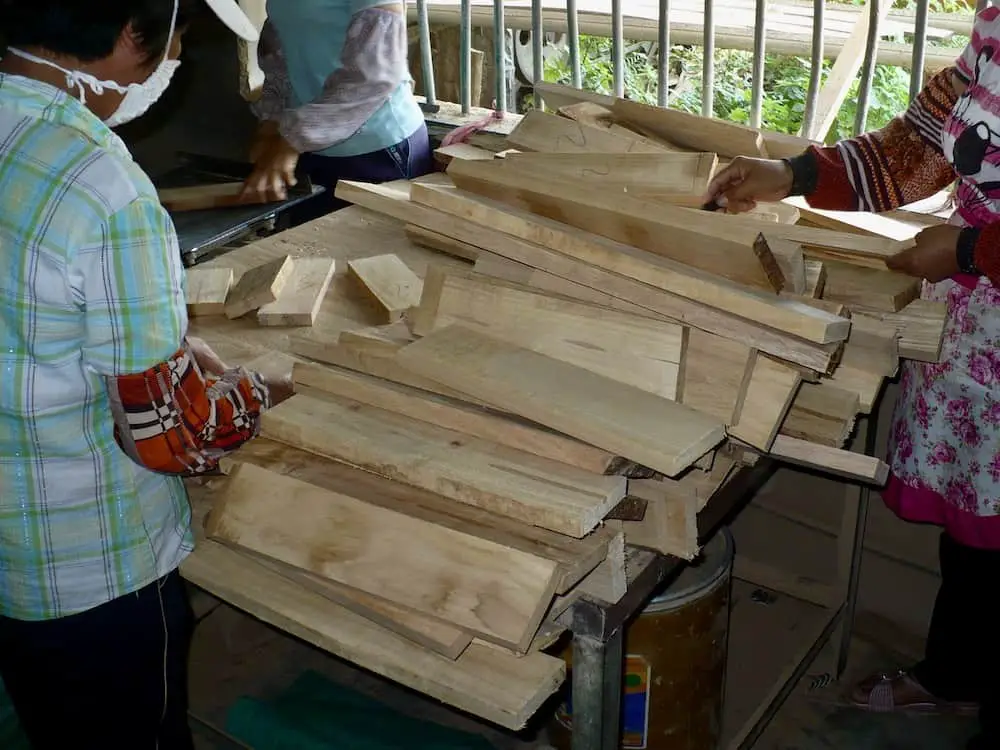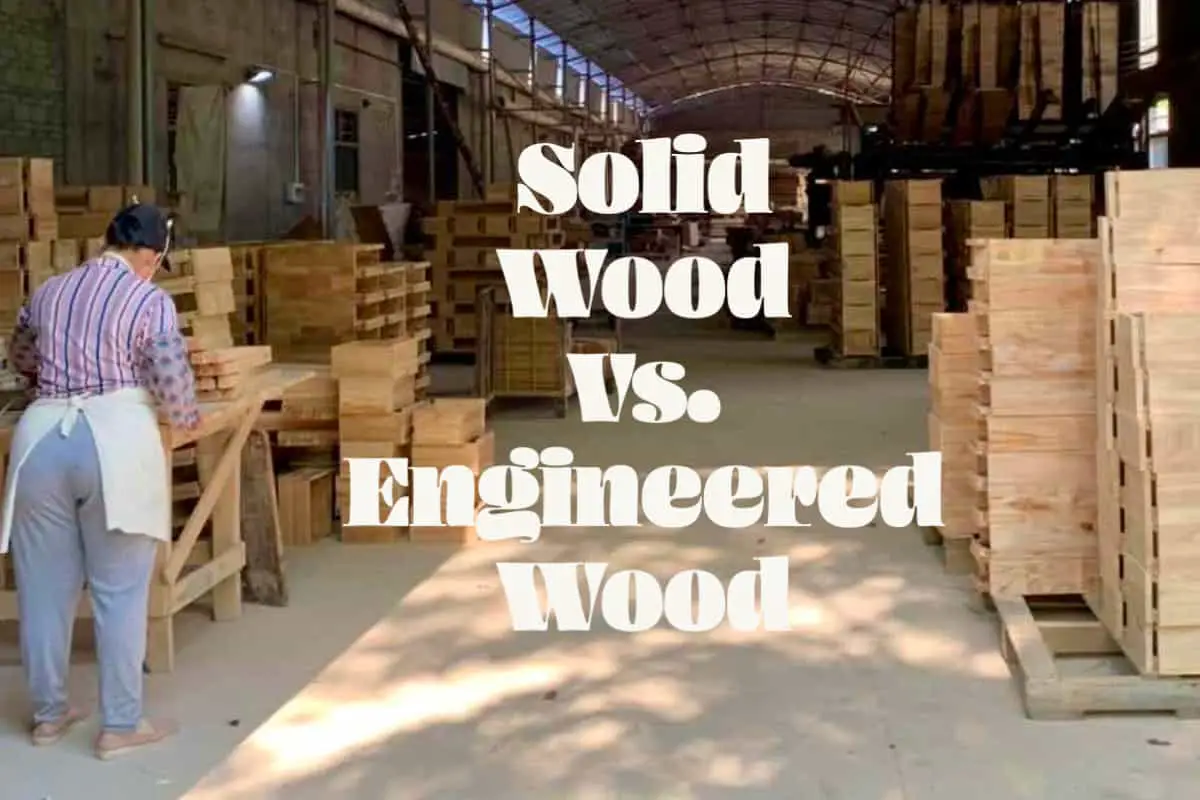When most people purchase a piece of furniture, they want to understand what kind of wood was used to manufacture it. They may want to understand the difference between solid wood and engineered wood.
Solid wood is cut down from the tree, cut into wood boards, and then used for manufacturing. On the other hand, engineered wood is considered man-made as it is usually manufactured with wood chips or wood shavings and an adhesive. Today the manufacturing of engineered wood is extremely technical.
Table of Contents
- Solid Wood Vs. Engineered Wood
- Characteristics of Solid Wood Vs. Engineered Wood
- Is Engineered Wood Better Than Solid Wood?
- Related Questions
Solid Wood Vs. Engineered Wood
Even though solid wood and engineered wood may look very similar on a product’s surface, they are not the same. How solid wood and engineered wood is used in manufacturing and is manufactured is completely different.
Solid wood is wood that is cut from a tree into wood boards or lumber. It is solid wood all the way through, and you can see the natural grain of the wood all the way through the wood boards.
To find out more about solid wood, you can read our blog All About Solid Wood Furniture by clicking here.
As the name implies, engineered wood is a human-made wood that has somehow been engineered. That does not mean the engineered wood does not contain wood chips or wood dust, but the wood is manufactured in a manufacturing facility before it can be used. It is bound together with some glue or adhesives.
Engineered wood has been around for a while. Archaeologists found traces of laminated wood in the tombs of Egyptian pharaohs. Thousands of years ago, the Chinese used shaved wood with glue to make furniture. The English and French used a kind of plywood in the 17th and 18th centuries.
Engineered wood is not new. It has been around for a while. But what is new about engineered wood is how the industry has changed over the years.
As the engineered wood industry has changed, so has the technology that is used to make engineered wood. Today engineered wood is a very high-tech wood that is very versatile and can be used in many ways.

Characteristics of Solid Wood Vs. Engineered Wood
Below is a chart that lists out some of the characteristics of solid word versus engineered wood.
| Characteristics | Solid Wood | Engineered Wood | |
| Type | Natural Product | Man-made | |
| Source | Cut From Trees | Mass timber, composite wood, man-made wood, and manufactured board. | |
| Names | Solid wood, lumber, natural wood | Binding or fixing the strands, particles, and fibers with adhesives. | |
| Manufacturing | Trees are cut into boards. | It can be manufactured to be very strong, and in some cases stronger than natural wood. | |
| Stability | May warp or crack if not treated properly | Very Stable | |
| Strength | As strong as the wood used. | It can be used for any part of a furniture item, construction, or flooring. | |
| Use | Can be used for any part of a furniture item, construction or flooring. | Use will depend on the design and shaping required but used in both furniture, construction and flooring. | |
| Veneer | Veneer has been put on solid wood, but not very common or stable | Handles wood veneer and other veneers very well. | |
| Moisture | Must be properly cured and dried to a certain moisture content. Moisture control is very important. | Moisture control is not as important as the wood is very stable. | |
| Regulations | Main regulations are if the wood cut is considered restricted or endangered. | Has regulations as CARBS and other regulations. This is because of the adhesives used in manufacturing Cost Cost will depend on what kind of wood is being used and the overall design. | Can be cheaper than solid wood, but this is not always a hard fast rule as it depends on many factors. |
Is Engineered Wood Better Than Solid Wood?
Today, the manufacturing of engineered wood is very high-tech. The quality of engineered wood has increased significantly over the last 20 years.
Because engineered wood has improved so much over the years, many people wonder if engineered wood is better than solid wood. This is not an easy answer as there are so many variables in how solid wood and engineered wood are used.
Here are some examples of when engineered wood can be a superior choice.
- Large tops or surfaces – Today, many large tabletops or surfaces are made using engineered wood. This t is because solid wood can be quite difficult or expensive to use on a large top or surface. Even with the best moisture control, solid wood could crack or warp on a large surface. This is why many large tops or surfaces use a form of engineered wood.
- Designed to Meet Applications – Because engineered wood is human-made, it can also be designed or manufactured to meet a specific application or performance requirement. This is very different from solid wood, a natural material, and limited by the characteristics of the tree species used.
- Wood Veneers – A major way that engineered wood is used is as the base for applying and gluing veneers onto its surface. Using a board such as MDF or plywood is ideal for applying the veneer onto the surface. There are many decorative ways that veneer is used that will not work well with solid wood.
- Stability – Engineered wood is more stable than solid wood. In many cases, it is also cheaper. So many manufacturing techniques require that engineered wood be used and not solid wood. This is because engineered wood is generally considered to be more stable than solid wood. For example, we use engineered wood in our production of lacquer or mother pearl products. The reason is that the engineered wood is far more stable than any solid wood.
The difference between solid wood and engineered wood is that solid wood is cut from a tree, and engineered wood is human-made or manufactured. Both of these woods are used a lot in home decor and home furniture products. Using either of them can be very technical, so you must work with manufacturers who understand these woods.
If you would like to learn more about how Mondoro can help you with your home decor or home furniture product development needs, we would love to hear from you. Please feel free to contact Anita at Mondoro by clicking here.
Find out more about how Mondoro can help you create, develop, and manufacture excellent home decor and furniture products – don’t hesitate to contact me, Anita. Check out my email by clicking here or become a part of our community and join our newsletter by clicking here.
Mondoro gives out a FREE Lookbook to anyone interested. You can receive a copy of our latest Lookbook by clicking here.
Listen to our Podcast called Global Trade Gal. You can find it on all major podcast platforms. Try out listening to one of our podcasts by clicking here.
Subscribe to our Mondoro Company Limited YouTube Channel filled with great videos and information by clicking here.
Related Questions
What Are Things To Consider When Finding A Solid Wood Manufacture to Manufacture Your Products?
One of the things we look at when we go into a new solid wood furniture manufacturer is if they have in-house kiln wood drying. We would also like to know if they understand how to join the wood properly and if they have the equipment to do it. Also, if the manufacturer is in a hot and tropical climate, if they have a dry room to help control the wood moisture levels. We like to work with factories that will cut and shape all the wood themselves and also have in-house finishing facilities.
You can discover more by reading our blog 5 Questions To Ask When Considering A Solid Wood Furniture Manufacturer, read more by clicking here.
What is the Teak Wood Used For Outdoor Furniture?
Teak wood is a hardwood that is native to many parts of Southeast Asia. Myanmar has over half of the world’s naturally grown. Today a lot of teak wood is plantation grown and managed with sustainability in mind. Teak wood has a lot of natural properties that make it a logical choice for outdoor furniture. But with any outdoor furniture, teak wood also needs proper cleaning and care for it to retain its natural color.
You can discover more by reading our blog All About Teak Wood And Outdoor Teak Furniture Care by clicking here.


